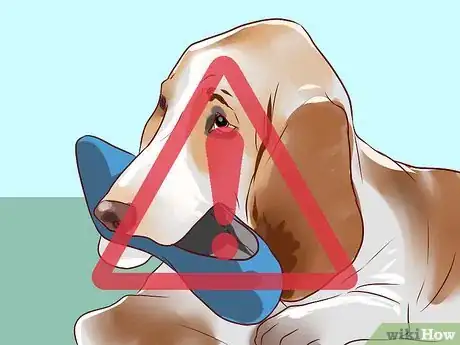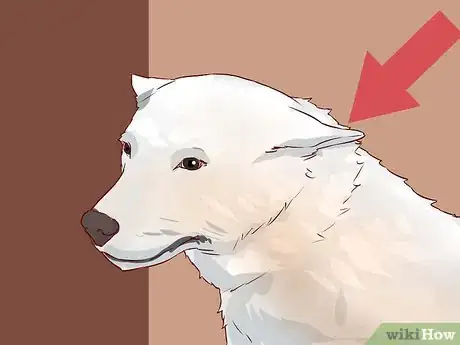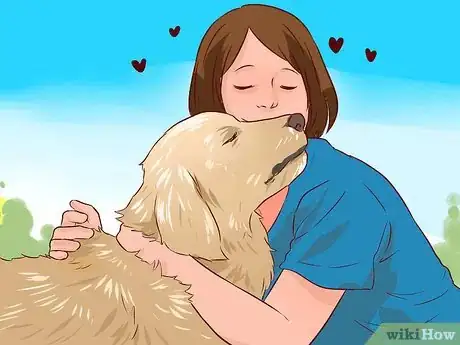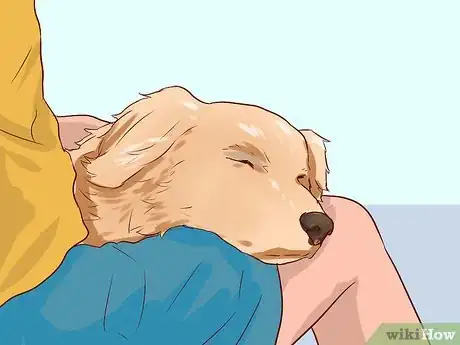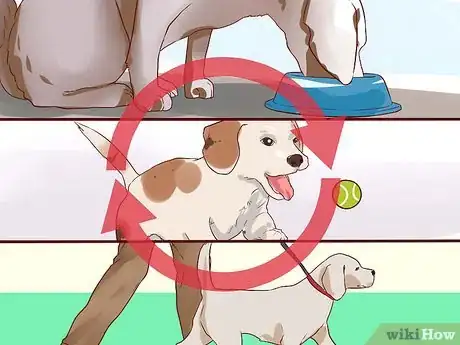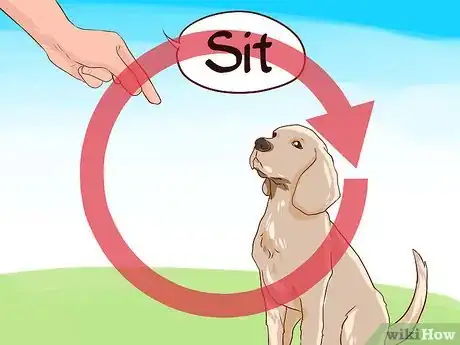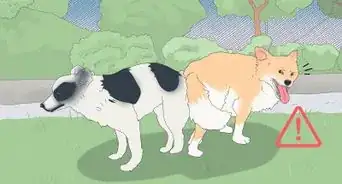This article was co-authored by Dominik Feichtner. Dominik Feichtner is a Professional Dog Trainer and Behaviorist and the Owner of The Dog Behaviorist NYC out of New York, New York. With over eight years of experience working with dogs, Dominik specializes in general obedience, behavior modification, and puppy training. His commitment to a balanced, common-sense approach led to his recognition as one of the “Best Dog Trainers in Brooklyn” and one of the “Best Dog Trainers in NYC” by Pooch and Harmony in 2020.
wikiHow marks an article as reader-approved once it receives enough positive feedback. In this case, 87% of readers who voted found the article helpful, earning it our reader-approved status.
This article has been viewed 286,181 times.
While loving your dog might seem like a simple concept, there's more to than adoring him and spoiling him with treats and toys. Loving your dog is about building a strong bond with him and acting in his best interest. A well-loved dog will feel safe, cherished, and secure, yet still know and follow the rules of canine citizenship. If you take the right steps, you can remain in charge while still having a friendly relationship with your dog.[1]
Steps
Fostering a Healthy Relationship With Your Dog
-
1Know how to nurture your dog. Create rules and enforce them to show your dog that you love him. Rules and expectations will help your dog know what behavior is acceptable and what isn't. This way he won't have to worry about when he may or may not get in trouble. Your dog will know he's loved, because he feels safe in the knowledge that you're in charge and taking care of him.[2] [3]
- Part of nurturing your dog is rewarding your dog's good behavior with food, attention, or play, and knowing how to correct bad behavior. This way, he won't repeat the action.[4]
-
2Recognize the importance of boundaries. Since your dog will share your home, he needs to understand your rules and expectations, such as where to toilet, not chewing furniture, and not stealing food off of the table.[5] If you don't set limits, your dog will find yours by doing something that upsets you. Setting boundaries also helps him cope with the outside world, making him less likely to act out dangerously.[6]
- For example, if you don't set boundaries, don't be surprised if your dog one day tries to bite your partner or chews your favorite designer handbag.
Advertisement -
3Consistently enforce rules.[7] [8] When you notice your dog breaking a rule, don't just ignore it sometimes and enforce it other times. This will send a confusing message to your dog, so that when you do correct him, he'll become conflicted and distressed. He may even challenge you by growling or attempting to bite.[9]
- For example, if your dog is breaking a "no dog on the sofa" rule, distract him so he jumps down, then reward the good behavior of getting down. You may distract him by playing with his favorite toy or dropping a treat on the floor.
- If the dog disobeys you again, you may need to put a leash on him in the house to keep him off the sofa.[10] Or, you may need to put him out of the room, withdrawing attention.
-
4Read your dog's body language. Start paying attention to your dog's body language in order to understand your dog better and what he's trying to tell you. For example, pay attention to signs that your dog feels uncomfortable. His head will lower, he'll glance away, cower down, and tuck his tail low. This will tell you that he's stressed and help you respond to his discomfort.[11]
- By understanding how your dog feels, you can react appropriately by removing the dog from what's scaring him, distracting him with some training exercises, or backing away and reducing the pressure on your dog.
-
5Cherish your dog. Always respect your dog and the love that your dog has brought into the house. Be kind, caring and considerate in the way that you treat your dog. Your dog is a family member. Dogs read a lot into your tone of voice, so speak kindly to him and he will understand your intentions.[12]
- Make your dog feel secure by never fighting with your family in front of the dog. Watching an argument may distress him.
-
6Spend quality time talking with your dog. Your dog loves getting attention from you. Every day, set aside some time to spend with your dog, even if you're just watching TV together or stroking your dog's ears and resting. Make sure to talk to him, which will help develop your own language together. You might also encourage your kids or family members to read to your dog. Don't forget to rub, scratch, or massage your dog's tummy. This is a great way to show your love.[13]
- If your dog puts his head in your lap, it's not because he wants you to scratch behind his ears. He's actually trying to figure out where you've been, who you've been with, and what you just ate.
Creating a Safe and Healthy Environment
-
1Establish a routine. Routines give a dog a sense of stability,which makes them feel more secure.[14] He doesn't have to worry about future meals or walks because they always occur at set times. In a dog's world, routine means knowing what time he gets up, goes for a walk, has his meals, and when he's groomed. Having those things happen at a predictable time shows your love for your pet.[15]
- Experts believe that a grieving or depressed dog can be cheered up by enforcing a routine rather than deviating from it.
-
2Feed your dog a nutritious diet. While your dog may enjoy treats, this doesn't mean he should always get them, instead of nutritious food. Instead, talk with your veterinarian about recommending a healthy dog food and correct amount to feed your dog. This way, your dog gets the vitamins and minerals he needs to thrive.[16]
- By caring for your dog's health and only occasionally rewarding him with treats, you show him that you care.
-
3Give your dog a comfortable place of his own. Make sure your dog has his own sleeping area that's set out of the way of people or storage. This will give your dog a space to withdraw to if he's simply had enough and needs to relax or calm down. He should have a den or safe place that contains a comfortable bed.[17] [18]
-
4Give your dog plenty of exercise. Depending on your dog's breed, being cooped up could potentially drive him crazy. Working and herding dogs typically have a lot of energy, and that energy needs to go somewhere productive and fun. Play fetch to get your dog running around or go for a walk (or jog, if you both like a challenge). Walks also give a dog a chance to see their world and sniff around as dogs naturally do.[19]
- A well-exercised dog is a fulfilled dog, who is far less like to have behavioral issues such as destructiveness or disobedience.
- Small dogs have a lot of energy, but it is quickly used up. A short walk should give a small dog enough exercise for the day.
- Dogs with thicker builds are typically more sedentary and will be less interested in exercise. Still, it's good to get them outside once in a while.
-
5Have regular training sessions. Look into reward-based training programs. Try to do two 10 to 20 minute training sessions every day and make them fun. If your dog doesn't already know them, start with the basics like, "sit," "stay," and "come." Your dog will love earning rewards and showing off his skills to other people when he learns a trick.[20]
- Training keeps dogs mentally stimulated and is a great chance for some one-on-one attention, which they love. Keeping your dog mentally active is a great way to show you love him, because it adds purpose and stimulation to his life, and helps him look forward to each day.
-
6Reward your dog. Let your dog know he's behaving well by rewarding him with small food treats, extra praise, or a game with a favorite toy.[21] If you give food treats, choose ones that are healthy and made specially for dogs. Or, you can make them at home. Remember to immediately reward the dog for good behavior so that he makes a positive association with the action.[22]
Expert Q&A
-
QuestionHow do you help your dog feel comfortable?
 Osama MaghawriOsama Maghawri is a Dog Trainer and Founder of OneStopK9, a dog training service in Miami, Florida. Osama utilizes balanced training methods to teach communication between owners and dogs. He specializes in basic obedience and behavioral issues such as resource guarding, fear-based aggression, and leash reactivity. Osama also helps owners understand the behaviors of their breed and how to continue training on their own in the future.
Osama MaghawriOsama Maghawri is a Dog Trainer and Founder of OneStopK9, a dog training service in Miami, Florida. Osama utilizes balanced training methods to teach communication between owners and dogs. He specializes in basic obedience and behavioral issues such as resource guarding, fear-based aggression, and leash reactivity. Osama also helps owners understand the behaviors of their breed and how to continue training on their own in the future.
Professional Dog Trainer Consider crate training him, which gives your dog a space to lie down in. You may want to partially cover the crate, so it's secluded and he can feel like he's in a den. This will help him relax when he's overwhelmed or tired.
Consider crate training him, which gives your dog a space to lie down in. You may want to partially cover the crate, so it's secluded and he can feel like he's in a den. This will help him relax when he's overwhelmed or tired. -
QuestionIs it weird that I love my dog so much?
 Indigo WillIndigo Will is a Canine Expert, Trainer, and Founder and Owner of K9-INDIGO® Holistic Dog Training LLC™, a dog training service in Los Angeles, California. Indigo specializes in understanding canine temperament and dispositions to allow canines to reach their full potential. He has studied various methods of training and philosophies to develop a unique, innovative, and result-driven method for canine behavior training.
Indigo WillIndigo Will is a Canine Expert, Trainer, and Founder and Owner of K9-INDIGO® Holistic Dog Training LLC™, a dog training service in Los Angeles, California. Indigo specializes in understanding canine temperament and dispositions to allow canines to reach their full potential. He has studied various methods of training and philosophies to develop a unique, innovative, and result-driven method for canine behavior training.
Professional Canine Expert No, dogs are pretty lovable, and the bond between you and your dog can be pretty intense. If someone thinks it's weird that you love your dog, that's on them!
No, dogs are pretty lovable, and the bond between you and your dog can be pretty intense. If someone thinks it's weird that you love your dog, that's on them! -
QuestionIs it okay to play rough with your dog?
 Jaimie ScottJaimie Scott has been training dog owners as the Owner of Jaimie Scott Dog Training in Sacramento, California for the past 15 years. Jaimie meets clients for 1-on-1 training, group classes (owners only, no dogs), as well as live video classes. Jaimie has published videos, blog articles, and eBooks to share tips for training and his personalized insight into dog behavior. With a focus on training the owners, Jaimie believes that dogs need to know who’s in control at any given time in order to feel secure and be happy. Jaimie holds a BS in Mathematics and Computer Science from Pacific University.
Jaimie ScottJaimie Scott has been training dog owners as the Owner of Jaimie Scott Dog Training in Sacramento, California for the past 15 years. Jaimie meets clients for 1-on-1 training, group classes (owners only, no dogs), as well as live video classes. Jaimie has published videos, blog articles, and eBooks to share tips for training and his personalized insight into dog behavior. With a focus on training the owners, Jaimie believes that dogs need to know who’s in control at any given time in order to feel secure and be happy. Jaimie holds a BS in Mathematics and Computer Science from Pacific University.
Dog Owner Trainer It depends on what you mean by play rough. You certainly don't want to do anything that could risk the health or well-being of your dog or yourself. For example, lifting them off the ground with a rope and swinging them around is not a good idea, as it may harm your dog's teeth. If by playing rough, you mean getting them really worked up and excited, that's not a problem. Just remember to always end up with the toy at the end of the game, as it's important that the person in charge wins.
It depends on what you mean by play rough. You certainly don't want to do anything that could risk the health or well-being of your dog or yourself. For example, lifting them off the ground with a rope and swinging them around is not a good idea, as it may harm your dog's teeth. If by playing rough, you mean getting them really worked up and excited, that's not a problem. Just remember to always end up with the toy at the end of the game, as it's important that the person in charge wins.
Warnings
- Never hit your dog. He won't see it as a punishment, but only see it as you inflicting pain on him, and it won't do any good. Instead, use a firm voice, and ignore him for a few minutes. Never punish him or her if what he did was more than ten minutes ago. He won't remember what he did wrong.⧼thumbs_response⧽
References
- ↑ The Happy Puppy. Pippa Mattinson. Ebury Press
- ↑ The Happy Puppy. Pippa Mattinson. Ebury Press
- ↑ Dominik Feichtner. Dog Trainer & Behaviorist. Expert Interview. 18 March 2021.
- ↑ Dominik Feichtner. Dog Trainer & Behaviorist. Expert Interview. 18 March 2021.
- ↑ Osama Maghawri. Professional Dog Trainer. Expert Interview. 9 September 2020.
- ↑ The Happy Puppy. Pippa Mattinson. Ebury Press
- ↑ Osama Maghawri. Professional Dog Trainer. Expert Interview. 9 September 2020.
- ↑ Dominik Feichtner. Dog Trainer & Behaviorist. Expert Interview. 18 March 2021.
- ↑ In Defense of Dogs. John Bradshaw. Penguin.
- ↑ Dominik Feichtner. Dog Trainer & Behaviorist. Expert Interview. 18 March 2021.
- ↑ Indigo Will. Professional Canine Expert. Expert Interview. 8 September 2020.
- ↑ Indigo Will. Professional Canine Expert. Expert Interview. 8 September 2020.
- ↑ Indigo Will. Professional Canine Expert. Expert Interview. 8 September 2020.
- ↑ Osama Maghawri. Professional Dog Trainer. Expert Interview. 9 September 2020.
- ↑ In Defense of Dogs. John Bradshaw. Penguin.
- ↑ http://dogtime.com/dog-health/dog-behavior/4694-show-dog-love
- ↑ In Defense of Dogs. John Bradshaw. Penguin.
- ↑ The Happy Puppy. Pippa Mattinson. Ebury Press
- ↑ Indigo Will. Professional Canine Expert. Expert Interview. 8 September 2020.
- ↑ The Happy Puppy. Pippa Mattinson. Ebury Press
- ↑ Osama Maghawri. Professional Dog Trainer. Expert Interview. 9 September 2020.
- ↑ The Happy Puppy. Pippa Mattinson. Ebury Press
About This Article
To love your dog, spend quality time with it by talking to it and petting it. Additionally, give your dog plenty of exercise by playing fetch and going for walks. You’ll also want to exercise your dog’s brain with regular training sessions. When your dog behaves well, whether during a training session or in general, make sure to reward it with a small food treat, extra praise, or a game with a favorite toy. Another way you can nurture your dog is to feed it nutritious meals, and provide it with a space of its own, like a dog bed. For more tips from our Veterinary reviewer, including how to create a safe and healthy environment for your dog, keep reading!


